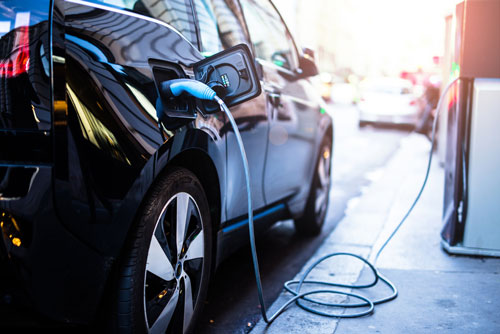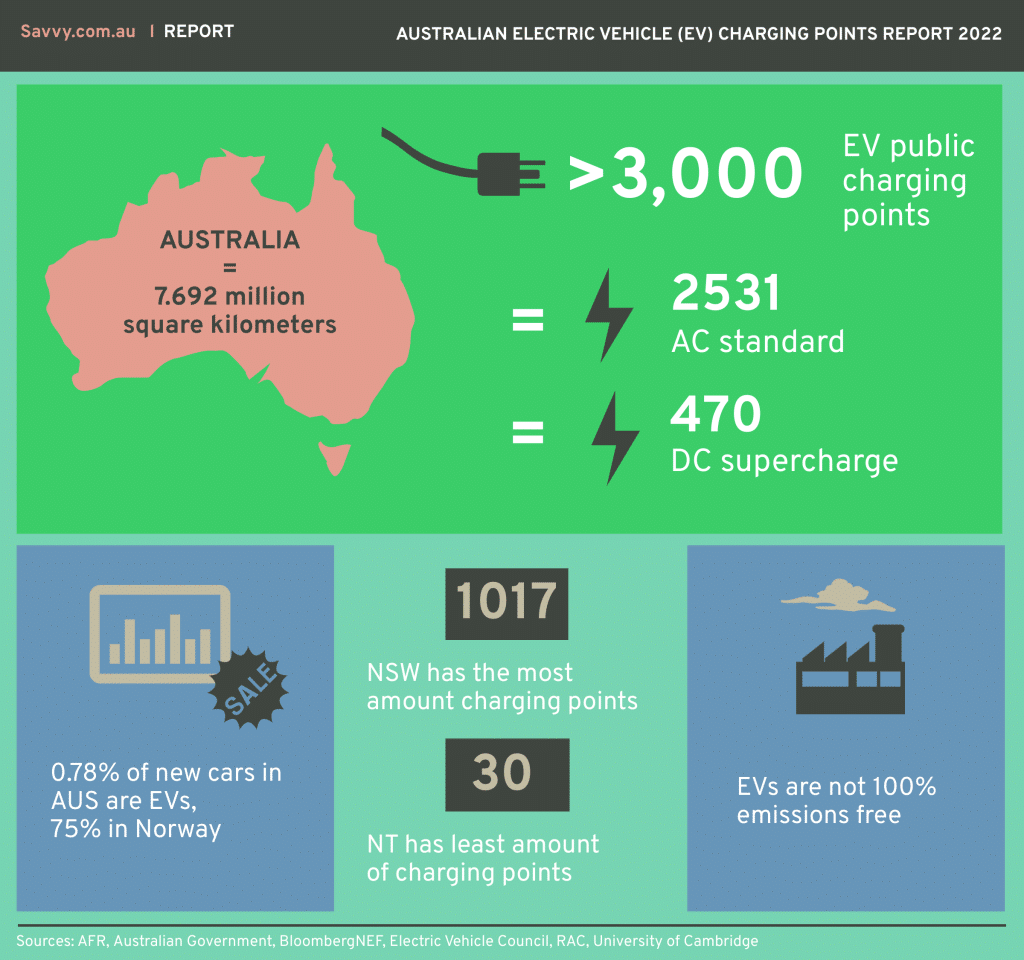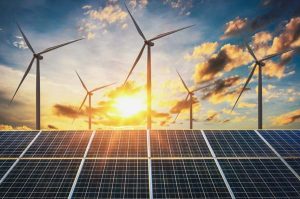
- The Savvy Promise
At Savvy, our mission is to empower you to make informed financial choices. While we maintain stringent editorial standards, this article may include mentions of products offered by our partners. Here’s how we generate income.
In this article
Are you keen to experience that new car smell of an EV? The driving influence for many is the excitement of a game-changer, chance to do the right thing and eventual cost savings. Yet, what is holding you back? They are expensive, that is certain. Increasingly many Australians are scared about finding charging points. What good is a car if it’s difficult to charge? Savvy investigated the problem for you.
- Australia currently has just over 3,000 EV public charging points (2531 standard AC, 470 supercharge DC) to cover 7.692 million square kilometres
- EV sales in Australia only represent 0.78% of new cars, compared to Norway at 75% and the world average of 4.2%
- The EV community plays the leading role in mapping charging points, most located in New South Wales
EVs in Australia vs the rest of the world
In 2022, the hype of electric vehicles (EVs) continues to grow in Australia and the world over. They are considered the future of transport and will help achieve aggressive net-zero targets set by many countries at COP26, last year in Glasgow.
In 2020, EV sales increased in Australia to 0.78%, but we are lagging way behind the rest of the world, with an average of 4.2%. Norway is the leader with almost 75% of new vehicle sales being electric ones, followed by Iceland (45%).

The Australian Government’s stance on EVs
The Australian Government has now embraced EVs, and is enabling their future use by the release of their Low Emissions Technology Statement 2021, where they specified ‘Enabling Infrastructure’ as a key category. Their plan is to invest in infrastructure that will allow the widespread delivery of low emission energy to the commercial and residential sectors. One of the two key priorities launched at COP26 in Glasgow, Scotland was to include more battery charging stations for EVs to ‘support consumer choice.’
This is a turnaround after Prime Minister Scott Morrison famously said in 2019 that an EV would not be going to ‘… tow your boat. It’s not going to get you out to your favourite camping spot with your family.”
The ‘Future Fuels Fund’ was part of the 2020-2021 Federal Budget which aims to ‘address barriers to the roll-out of new vehicle technologies'. It is managed through the Australian Renewable Energy Agency (ARENA). Its plan is to develop $500 million of charging infrastructure by co-investing with the private sector. A new round of funding will be announced in early 2022.
Despite the overall criticisms of the government's net-zero target shortcomings by 2050, most Australian states and territories have their own aggressive targets.
Global electric vehicle (EV) % of new sales market share in 2020
No Data Found
What are EV charging stations?
According to the Electric Vehicle Council, there are three levels of charging stations available in Australia. Generally, the higher the level, the faster you can charge your EV.
Level 1/Mode 2: Your at-home charging station
This is like plugging in any other electrical device at home, but you must use a special cable. It uses 10-15 Amp, single-phase power and delivers 1.4kW – 2.4kW. This will ‘top up’ any kilometres used from a small trip (10-20 km), but won’t fully charge your battery. This charging method will also be useful on destination trips if no other charging points are available.
Level 2/Mode 3: Charge while shopping
Using the power equivalent to an oven or dryer, this is a dedicated EV charger, delivering up to 22kW, on a 32 Amp, 3-phase point. It is normally found in public places such as shopping centres where the car can be left for an hour to top up daily usage (40 to 100km) or fully charge overnight.
Level 3/Mode 4: The DC supercharger
The two previous methods use AC power, but this one uses DC. Designed to be much quicker (up to 40x faster) at charging, it is suitable for fully charging a vehicle rapidly and is a dedicated point at petrol stations, car parks and generally where cars are found. It will deliver from 25kW to 350kW on a 40–500 Amp, three-phase point and charge around 150km per hour.
Generally the bigger the battery, the more it will cost to charge. The cost of charging publicly varies widely amongst the approximately 18 private charging infrastructure providers available. Prices will fluctuate depending upon demand, but many suppliers offer the first few kilowatts for free. The RAC estimates that costs are approximately 45 to 60 cents per kilowatt-hour maximum, which still makes them cheaper than their combustion engine counterparts.
Charging is simple too! All you have to do is remove the charger from the holster, insert it into your vehicle, press start and stop and return it to the holster. Easy!
Tesla electric chargers are a different beast though. They are the fastest chargers (called destination chargers), but can only be used on Tesla cars. Perhaps they are missing out on the potential of the whole EV user market?
Number of AC charging points for electric vehicles in Australia in 2021, by state
No Data Found
Number of DC charging points for electric vehicles in Australia in 2021, by state
No Data Found
Your fear vs reality: What’s the evidence?
A 2021 Savvy survey found 17% of respondents were most concerned about charging station availability when making an EV purchase. This proves that the accessibility of charging points could be a large restraint to EV market growth in Australia.
To cover the whole 7.692 million square kilometres we have in Australia, the Electric Vehicle Council in their State of Electric Vehicles 2021 report estimated there are over 3,000 public chargers in Australia with 470 supercharging ones. As for Tesla, there are currently around 40 destination chargers, Australia wide.
These figures above aren’t huge, for the potential growth in EVs popularity. By the end of 2022, it is estimated that there will be 58 EV models for sale on the Australian market, a rise of 53% from 31 models in 2021.
% of AC vs DC charging points in Australia
No Data Found
Installations of public chargers increased by 23% (DC) and 24% (AC) from 2020-21 and at present, for every public charger, there are 7.21 EVs in Australia.
The biggest hindrance to the growth of the EV market overall in Australia is the lack of charging stations and it is a classic catch-22 rule. We can’t have more EVs on the road until we have more charging stations and we can’t have more charging stations unless we have more EVs. Therefore, we are reliant on government EV policies and funding and the growth that private providers can foresee and are therefore willing to invest upon, to fix the problem.
In the interim, how to negotiate the charging station challenge
Foremost, it would be obligatory to install your own charger at home.
Public charging stations pose a different challenge as they, unfortunately, aren’t always easy to find and their distribution depends upon the population, state, territory, local council implementation policy and willingness of private providers.
Luckily the EV community is there to save the day! A free app for iOS, Android and the internet called PlugShare allows users to find charging stations in Australia and worldwide, map new ones and share their EV activity with other fans. There are around 300,000 monthly active users who can even plan their trips (thus find charging stations on the way) and pay directly for their charging use through the platform.
Hopefully soon Google Maps will roll out their EV charging station finder that has been released in the United Kingdom and the United States.
For the interim, planning your trips and becoming friendly with the EV community to keep abreast of new developments and installations seem to be the keys to the problem.
EVs are only as clean as the electricity you use
Bloomberg, in their Electric Vehicle Outlook 2021, projected that if all road transportation was electrified, it would increase overall energy demand by 25% in 2050.
EVs are a step in the right direction against climate change, but they are not emissions-free. As the Australian Financial Review in 2021 pointed out that they are ‘only as clean as the electricity that powers them’, for most of Australia's energy is produced from coal combustion.
A study in 2020 from the universities of Exeter, Nijmegen and Cambridge discovered that even if their electricity comes from non-renewable sources, EVs are still better for the environment than their traditional counterparts in currently 95% of the world. However, this doesn’t apply to countries that produce most of their energy from coal. Yet, a country entirely reliant on coal for energy production is an unlikely scenario in the future.
Bloomberg's 2018 statistics estimated that China, which is the world’s largest consumer of coal for electricity, emits 188.5 grams of carbon dioxide (CO2) per mile of an electric vehicle. France produces just 2.7 grams as most of its electricity is nuclear. Yet, again, despite this varied range of EV emissions, they are still much better than their gasoline-powered equivalents, producing 248.5 grams per mile.
Bill Tsouvalas, Managing Director of Savvy said:
‘The hype of EVs is one thing and the reality is another. Although EVs have huge potential to combat climate change (the hype), the availability of charging points in Australia is limited, particularly if you live in a sparsely populated area (the reality). Only the brave adopters have switched over to the user side and are leading the charge for the rest of us to follow.’
He continued:
‘It has been overheard many times that 'Your next car purchase will probably be an electric one' and this may well be true. Obviously, there are many points that need to be addressed for the average consumer to take the first step (notably availability and price), but with more charging points available Australia-wide, it will make this first step less scary and much, much easier.’
How to do the right thing
If you have decided to take a step to purchase an EV, or have already done so – you are probably passionate about climate change. This car is your commitment to playing your part in making a difference. If you don’t have solar energy to fuel your charging at home, make sure you have renewable energy selected and provided by your electricity supplier!
EVs are only part of Australia’s plans to achieve net-zero targets, but ultimately, the implementation of more renewables as a source of electricity generation will make the real difference.
Australian Financial Review (AFR), 'After mocking electric cars, PM now embraces them', released November 2021
Australian Financial Review (AFR) 'How to drive a real transition to electric cars', released November 2021
Australian Government, 'Future Fuels Fund (Round 1)'
Australian Government, Technology Investment Roadmap: Low Emissions Technology Statement 2021
BloombergNEF, Electric Vehicle Outlook 2021
Electric Vehicle Council, State of Electric Vehicles report, released August 2021
Royal Automobile Club of Victoria (RAC), 'What does it cost to charge an electric car?' released October 2021
University of Cambridge, 'Electric cars better for climate in 95% of the world, released March 2020
World Economic Forum, 'The surprising truth behind the world's electric cars', released March 2018
Did you find this page helpful?
Author
Thomas PerrottaGuest Contributor
Bill TsouvalasPublished on February 8th, 2022
Last updated on March 18th, 2024
Fact checked
This guide provides general information and does not consider your individual needs, finances or objectives. We do not make any recommendation or suggestion about which product is best for you based on your specific situation and we do not compare all companies in the market, or all products offered by all companies. It’s always important to consider whether professional financial, legal or taxation advice is appropriate for you before choosing or purchasing a financial product.
The content on our website is produced by experts in the field of finance and reviewed as part of our editorial guidelines. We endeavour to keep all information across our site updated with accurate information.










